June 4, 2021
Today I want to talk about one of the topics I’m most passionate about: how to “Leave No Trace” at Mt. Rainier. Whether you’re having a mountain wedding at Rainier or are just visiting for a vacation, knowing and understanding these principles is hugely important in making the least impact possible + protecting the mountain land.
I’m obsessed with photographing couples in our incredible PNW landscapes. I’m also obsessed with showing these locations to my clients and pals. I believe that the outdoor world is for everyone. The outdoors are healing. And the outdoors are pretty damn cool to experience.
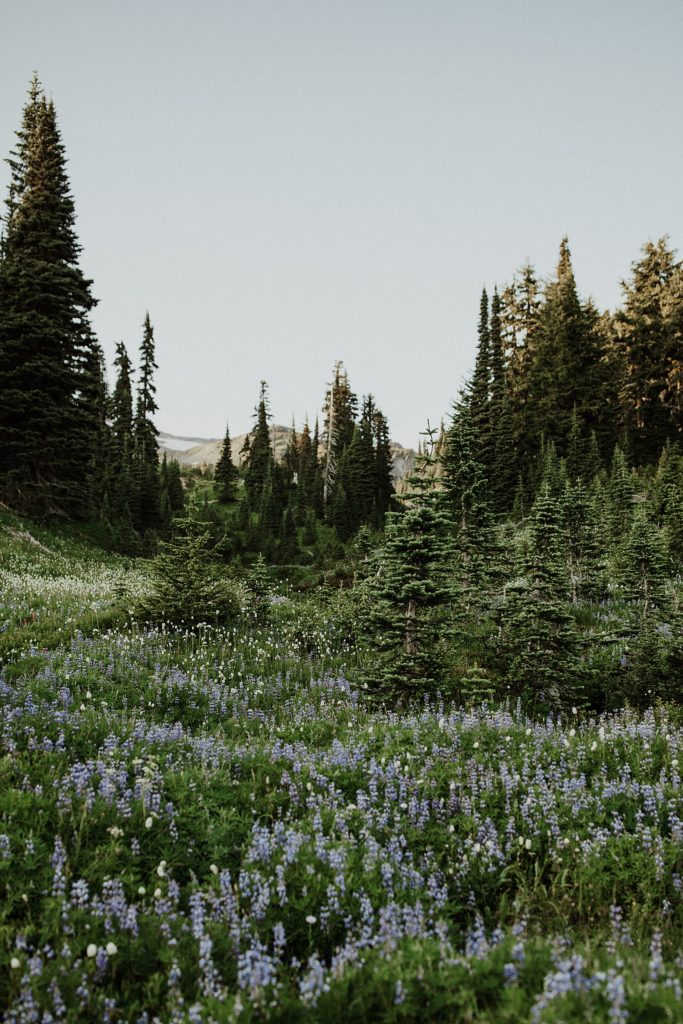
In this blog post, I’ll first be going through the basics of each of the 7 Leave No Trace Principles. Then, I’ll be relating each one to eloping at Mt. Rainier + how you can incorporate each principle into your big day. Let’s dive straight in!
**I’ll be taking lots of information from the Leave No Trace website, where you can find even more information + further resources!**
What does it mean to “leave no trace?”
If you know me, you know I’m a big advocate for protecting the environment and being really intentional about it. Not just by throwing your trash away (which you should always, always be doing), but by planning ahead to make the smallest impact possible on the land you’re going to be on.
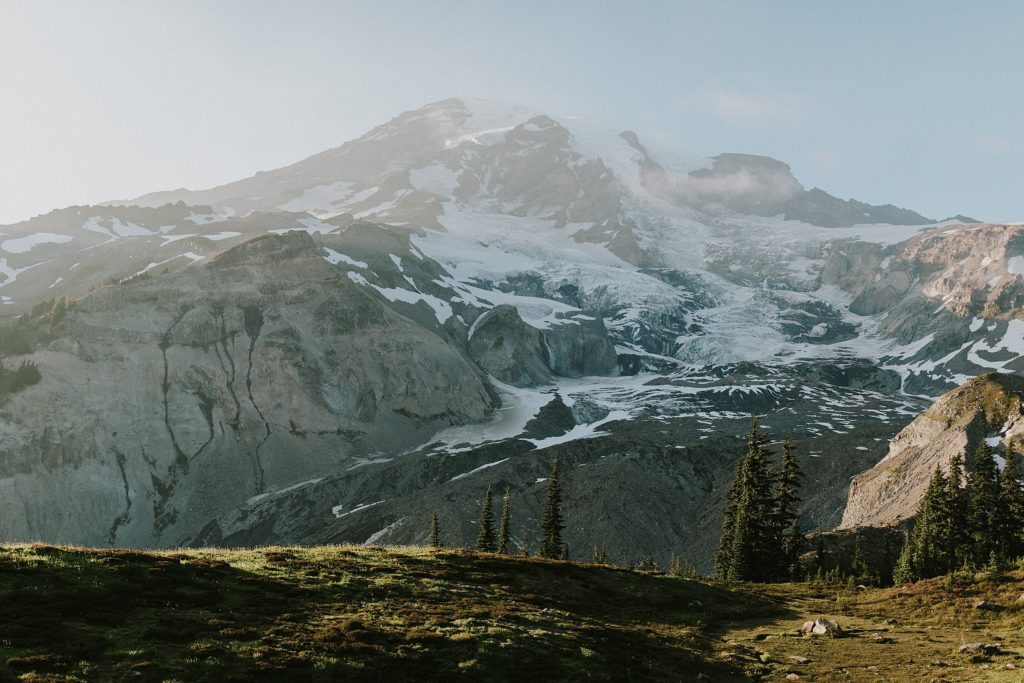
The Leave No Trace Center for Outdoor Ethics is an organization that is dedicated to researching + figuring out ways to help people around the world care about the outdoors. Their goal is to teach people how to enjoy the outdoors and be present in nature while minimizing our impacts and respecting the land we walk/climb/hike on.
The Leave No Trace organization focuses on:
- Removing trash from natural areas
- Minimizing water pollution
- Stopping the spread of misinformation about the outdoors
- Protecting at-risk wildlife
- Avoiding trail erosion + damage to trails
- Avoiding destructive wildfires
- Connecting youth to nature
- And finally, avoiding overcrowding parks
You can read more about their mission + goals here.
They’ve created seven principles to teach people in order to solve the issues mentioned above, which is what I’ll be guiding you through today. Here’s what their website has to say about the principles:
“The Seven Principles of Leave No Trace provide an easily understood framework of minimum impact practices for anyone visiting the outdoors.
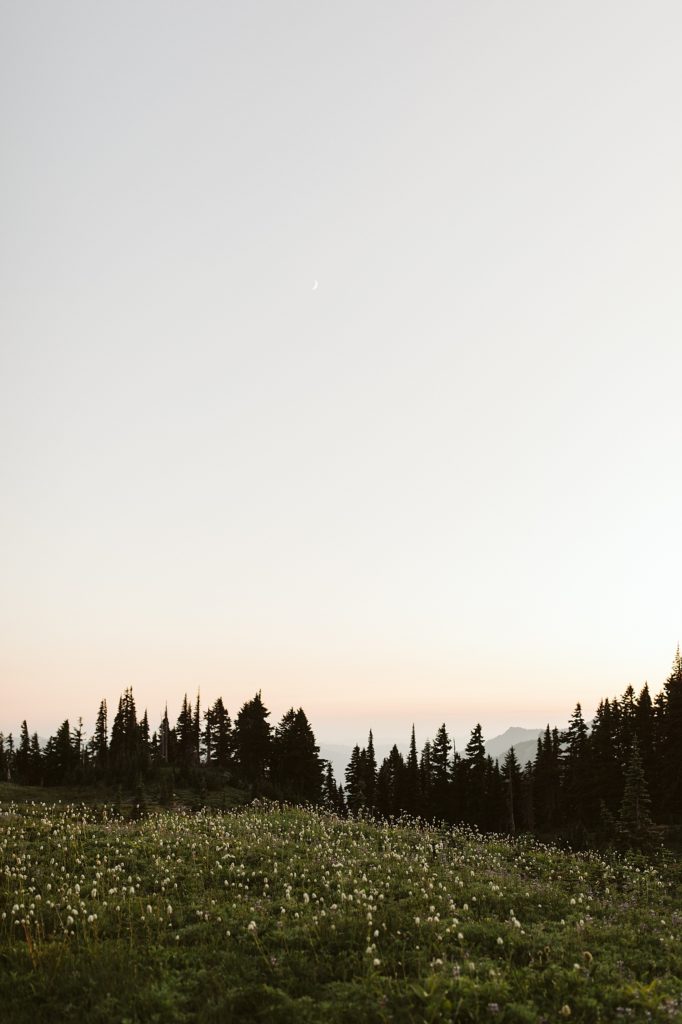
Although Leave No Trace has its roots in backcountry settings, the Principles have been adapted so that they can be applied anywhere — from remote wilderness areas, to local parks and even in your own backyard. They also apply to almost every recreational activity.
Each Principle covers a specific topic and provides detailed information for minimizing impacts.”
The 7 Leave No Trace Principles you should know
Now that we’ve gone through what the Leave No Trace organization is, let’s get into each one of the principles + how you can apply them to your time in the outdoors.
1. Plan ahead + prepare
This principle is all about planning in advance instead of making plans at the last minute, and not thinking them through enough.
Planning for an outdoor trip last-minute can be super fun, but can lead to much less intentional preparation in terms of the impact you have on the environment. Especially if you’re not yet used to thinking about how to leave no trace – it takes some practice to think about these principles naturally! Minimal planning can also cause safety issues if you end up doing activities you’re not properly prepared for.
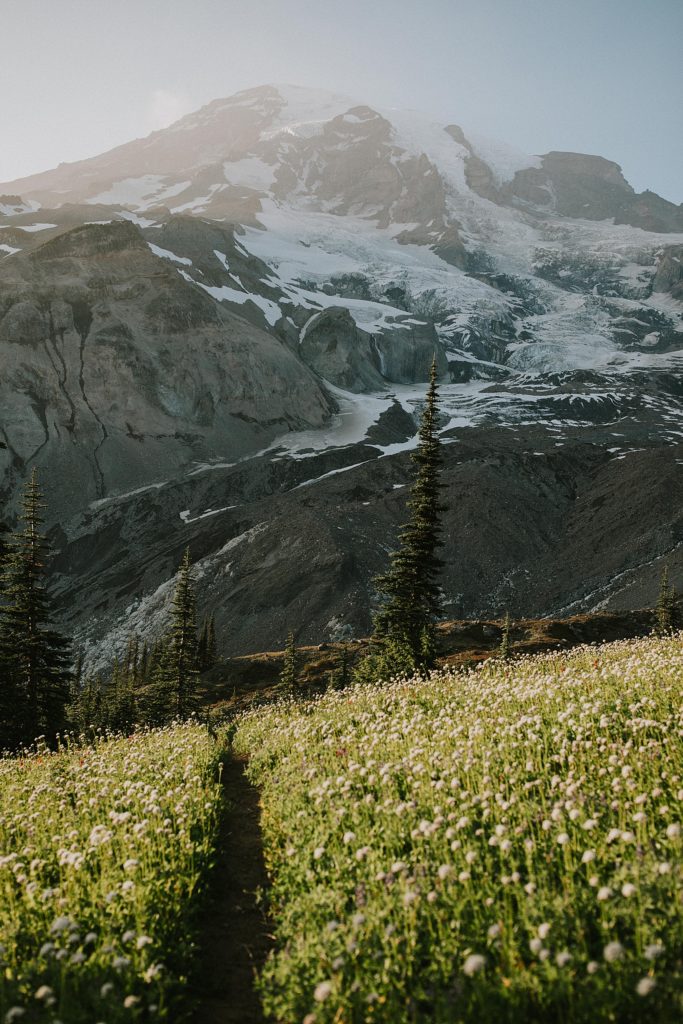
According to the Leave No Trace website, trip planning is important for a few reasons:
- It helps you make your trip successful and stay safe
- It can bring your confidence up + bring you more opportunities to learn about the nature/location you’re visiting
- You’re more prepared to minimize your impact on the location you’ll be at
- It ensures you + your travel group members will be safe
Here are the top 7 elements to consider when planning a trip, as the LNT website talks about:
- “Identify and record the goals (expectations) of your trip.
- Identify the skill and ability of trip participants.
- Gain knowledge of the area you plan to visit from land managers, maps, and literature.
- Choose equipment and clothing for comfort, safety, and Leave No Trace qualities.
- Plan trip activities to match your goals, skills, and abilities.
- Evaluate your trip upon return note changes you will make next time.”
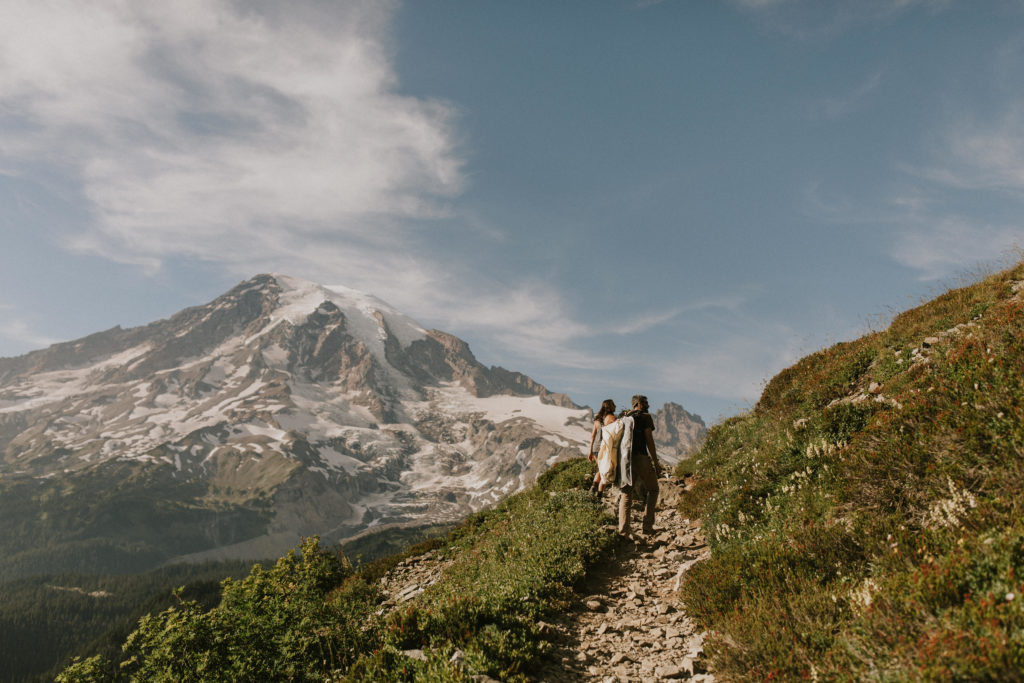
You’ll also want to plan for all kinds of weather conditions, the terrain you’ll be on, private land boundaries, your group size, and any kind of restrictions you might encounter.
2. Travel + camp on durable surfaces
While on your trip, you need to be intentional when you walk through natural areas not to damage the land or vegetation.
To do this, travel on trails.
So often I see people taking photos at pretty spots that aren’t on trails, and without even realizing it, they’re destroying the vegetation under their feet just for that Instagram photo. A good rule of thumb: just because everybody else is doing it, doesn’t mean it’s a smart decision.
Disclaimer: The image below appears to show the couple standing on wildflowers; however, they are actually standing on a paved trail you can’t see from this angle! This is one my favorite spots in the park because it has an incredible view of the mountain, has tons of wildflowers, AND both my couple and I are on the trail. With a little camera angle magic and planning ahead, we can stay on the maintained trails, and save delicate alpine meadows for future generations.
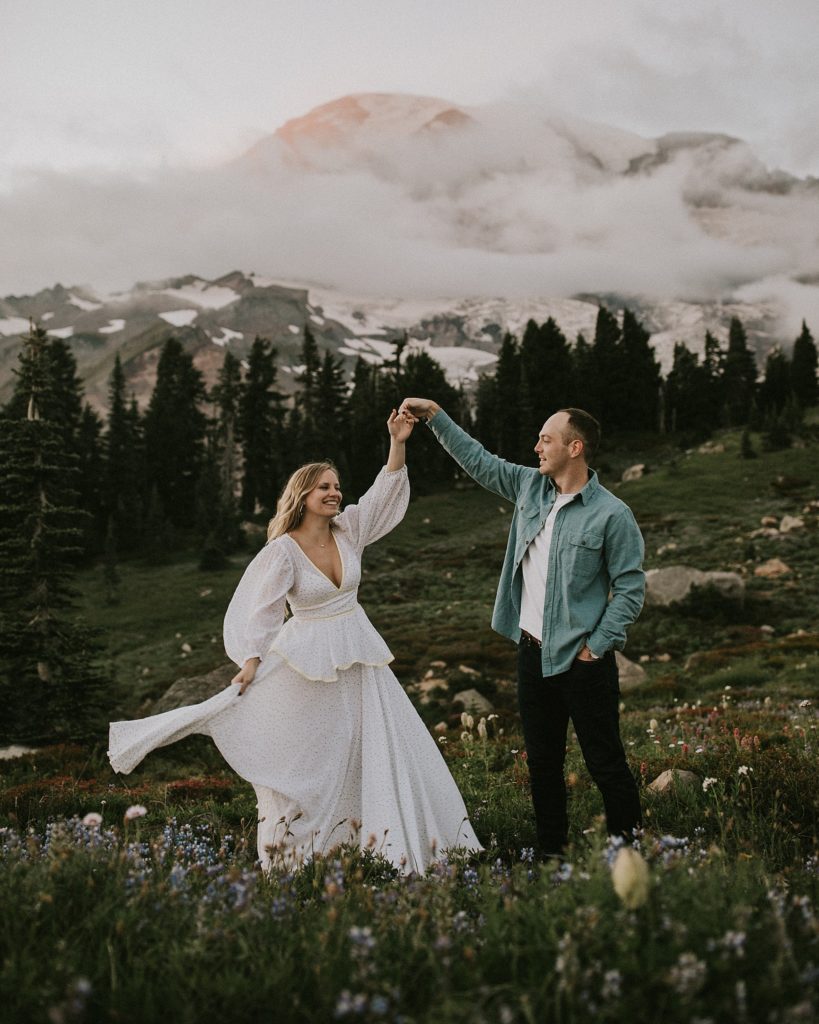
If there’s a spot you always see photos taken at, but you have to go off-trail or step on vegetation to get to it, please don’t do it. That photo isn’t worth the damage you’ll be doing to the land, I promise you. And then if you do it, other people will see that + think it’s okay for them to do the same. The cycle will just continue on.
Traveling off-trail
If you’re at a spot that doesn’t have trails (such as a campground or walking somewhere to use the bathroom), be mindful of where you’re walking. Pay attention to two things: the durability of the surface and the frequency of use.

If you’re on a surface such as living soil or areas of vegetation, be mindful that they are more susceptible to damage from feet + shoes, and aren’t super durable compared to surfaces such as sand or rocks.
If you see an area of vegetation where you can tell people have walked previously (e.g. the flowers or plants are trampled, you can see footprints in the soil, etc.), avoid that area.
3. Dispose of waste properly
This is such a simple one: please clean up your waste!

If you use the bathroom in the woods somewhere, bury what you leave down in the soil. Make a plan for what you’ll do with your bathroom waste – will you be camping somewhere with an actual restroom? Will you be out on a raft and need some sort of reusable toilet system? Some environments require all solid human waste to be packed out and not buried, so do your research depending on the location you’ll be at.
And as far as trash goes, “pack it in, pack it out:” this means if you’re bringing something with you, you need to clean it up. Pack out your kitchen waste (e.g. leftovers), your trash, cigarette butts, plastic bags, etc.
4. Leave what you find
This one is pretty self-explanatory: leave things how you found them. This applies to vegetation, flowers, campgrounds, facilities, and anywhere you go in the outdoors.
Don’t trample those flowers for the pretty photo. Don’t take that cool rock because you want to put it on your desk at home – leave it where you found it. Avoid carving anything into trees or hammering a nail for your hammock to hang on.
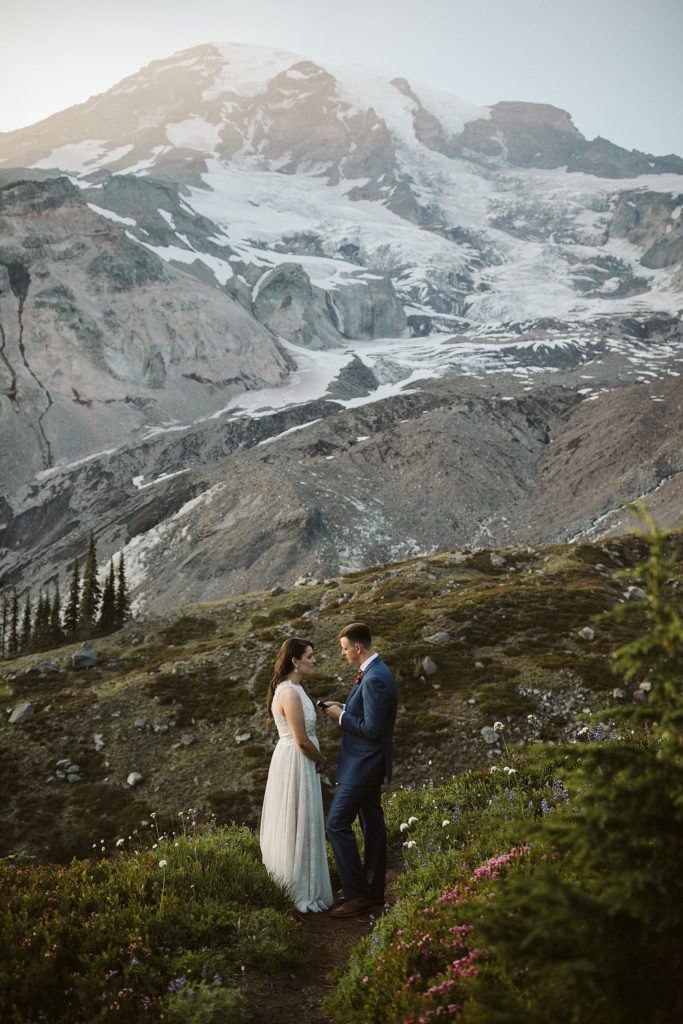
As the LNT website says, “Picking a few flowers does not seem like it would have any great impact and, if only a few flowers were picked, it wouldn’t. But, if every visitor thought “I’ll just take a few,” a much more significant impact might result.” Instead, take a photo of it to remember for later!
5. Minimize campfire impacts
Building a campfire is an important skill to have if you spend time outdoors away from artificial heating systems. However, many people don’t take into account the effects it’ll have on the environment they build it on.
The LNT website says to ask these questions when considering if you should build a fire or not:
- What is the potential danger to the backcountry?
- What is the fire danger for the time of year + location you have selected?
- Are there any current administrative restrictions from the agency that manages the area?
- Is there sufficient wood so its removal will not be noticeable?
- Does the harshness of alpine and desert growing conditions for trees and shrubs mean that the regeneration of wood sources cannot keep pace with the demand for firewood?
- Do group members possess the skills to build a campfire that will Leave No Trace?
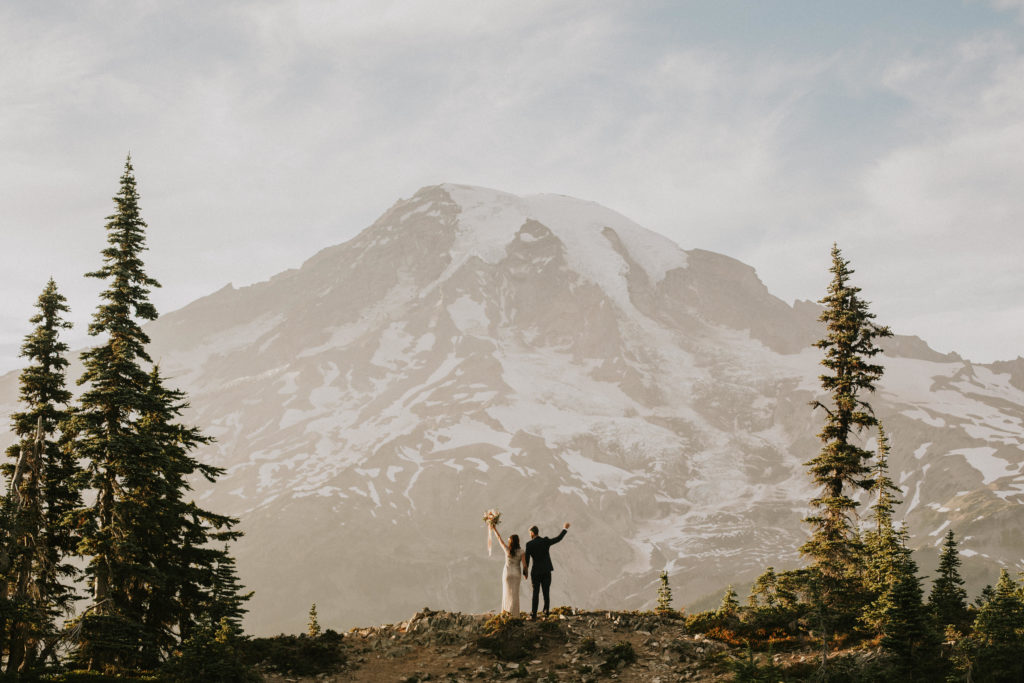
When building a fire, here are some ways to lessen the impact you cause:
- Build a fire within an existing fire ring, if possible
- Build it on top of a ground cloth – called a “mound fire”
- Use fire pans
- Clean up your wood + put the fire out properly
Read more about lessening campfire impacts on the LNT website here.
6. Respect wildlife
Avoid doing anything that will disrupt wildlife in the natural area you’re in.
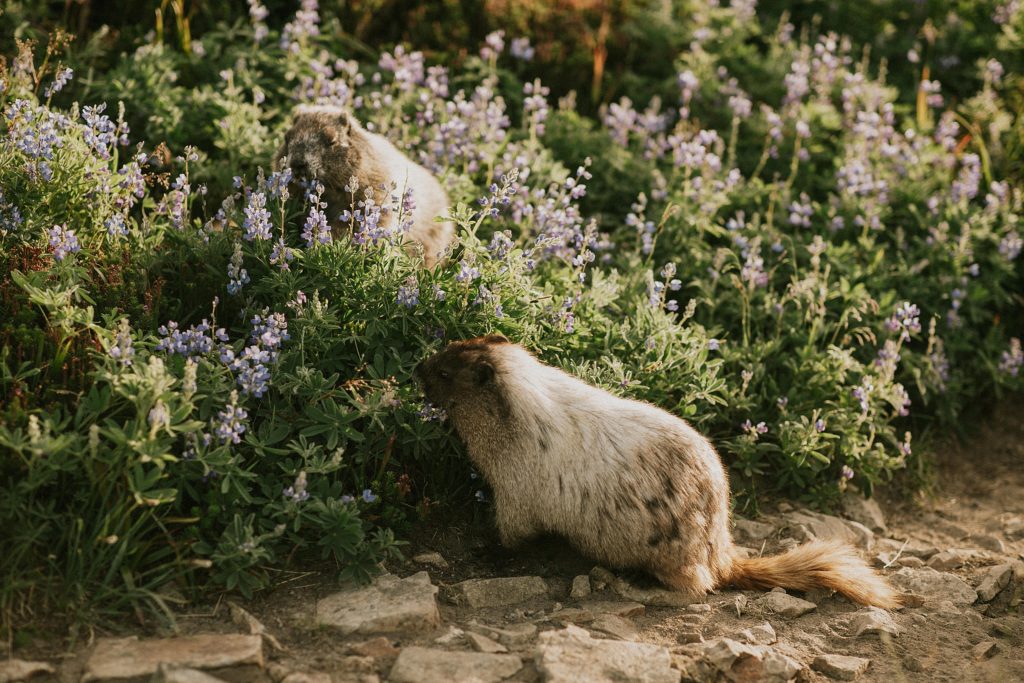
Don’t get closer to an animal just because it’s cute or you want to see more of it! Observe from a distance and don’t make any sudden movements that could be stressful to the animals.
7. Be considerate of other visitors
Lastly, it’s incredibly important to be considerate of other people visiting the area. We want everyone to enjoy their outdoor experience and not have it be disrupted by fellow disrespectful visitors!
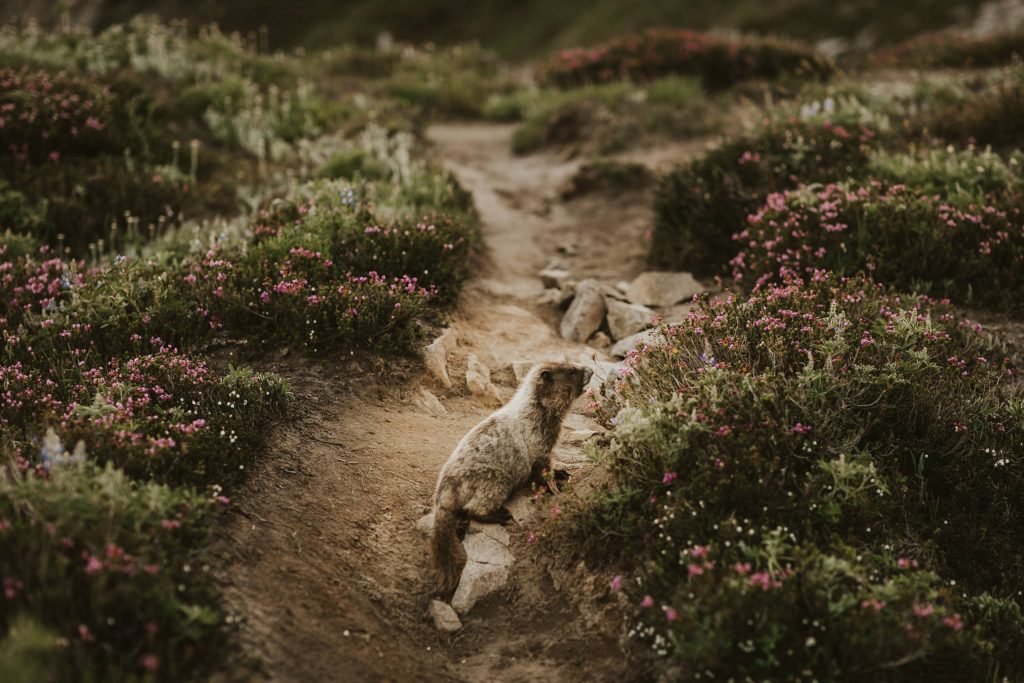
Avoid making loud noises, letting pets off their leash, and listening to music/podcasts without headphones. Some folks like to enjoy nature in solitude, while others like to listen to music – either way, be respectful of others who may not enjoy nature in the same way as you do.
How to leave no trace with your Mt. Rainier wedding/adventure elopement
Now that you know about each of the 7 Leave No Trace Principles, I’m going to give you examples of how you can incorporate this knowledge into your Mt. Rainier wedding or adventure elopement!
Mount Rainier National Park is one of my absolute favorite spots to visit + take my couples to – I submitted it in 2019, have two more summits planned for this summer, and don’t have any plans to stop going. It’s a really special place to me and I want to protect it as much as possible, both when I visit alone + when I photograph couples there.
1. Planning + preparing for your Rainier elopement
Planning ahead of your elopement at Rainier is essential to creating a smooth elopement day + minimizing our impact.
Mount Rainier National Park is such a popular place in the PNW for adventure elopements + weddings because of its insanely beautiful scenery, and we need to make sure we keep it that way.
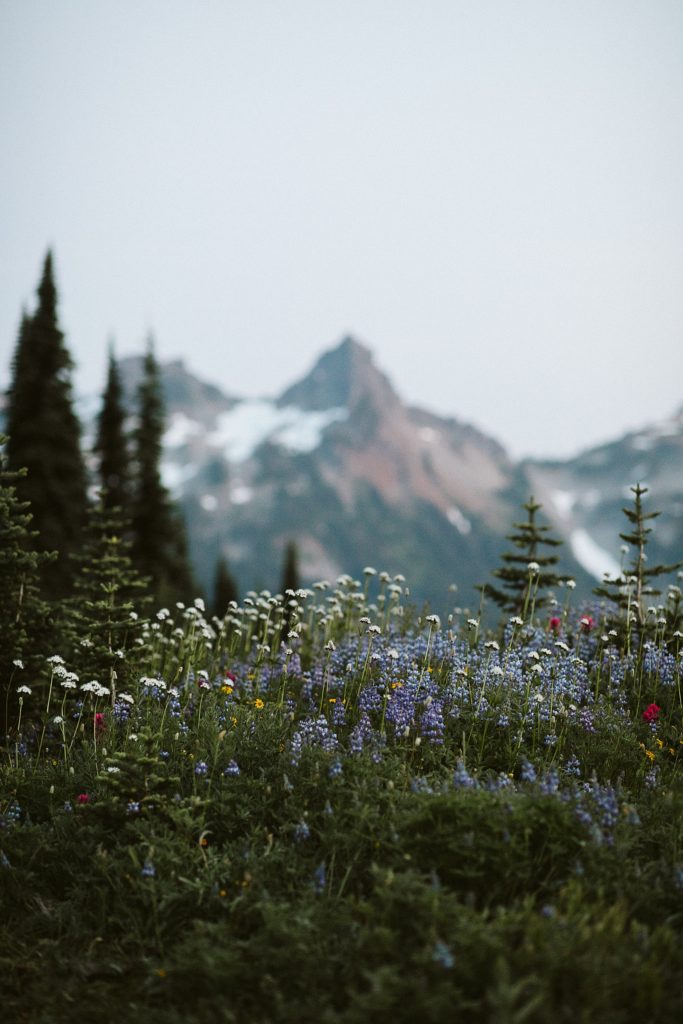
You, as the couple, and I, as the photographer, are both equally responsible for minimizing our impact when we visit Rainier for your big day. To do that, we need to prepare appropriately.
This preparation includes:
- Knowing where you’ll be staying, if you’re camping/staying overnight nearby your elopement location
- Planning your timeline ahead of time so we know what the day will look like
- Doing our research on each location we’ll be hitting in the national park, and preparing for the time of day, weather, and what the area will be like
- Making sure you pack the right clothes – coats, shoes, etc.
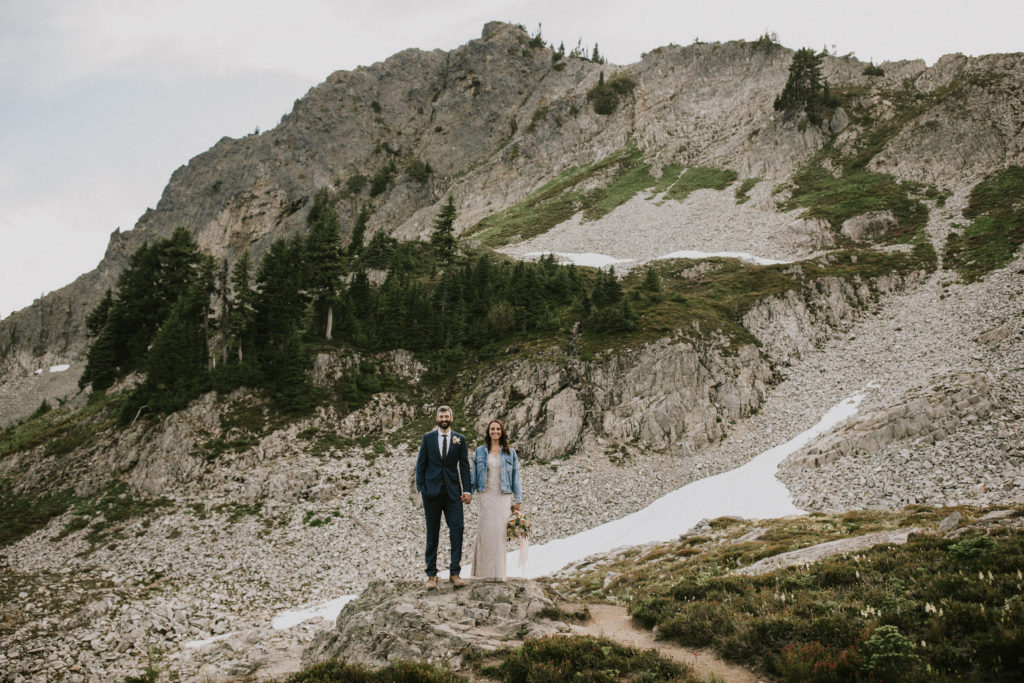
Basic rules + regulations at Rainier:
- Different park entrances + areas are open at different times of year, so do your research on location ahead of time
- Here’s a list of Rainier’s entrance fees + passes:
- Entrance Fees:
- Mount Rainier Single Vehicle Fee – $30.00
- Grants unlimited entry for one vehicle and passengers for seven consecutive days. Vehicle must be private, noncommercial, and with a seating capacity of 15 or less.
- Mount Rainier “Per Person” Fee – $15.00
- Walk-up or single bicycle fee. Grants unlimited entry for seven consecutive days.
- Mount Rainier Motorcycle Fee – $25.00
- Grants unlimited entry for one motorcycle and passenger for seven consecutive days.
- Mount Rainier Campground Fee – $20.00
- Fee per site, nightly, for camping in Cougar Rock, Ohanapecosh, and White River campgrounds. Learn more about camping at Mount Rainier at https://www.nps.gov/mora/planyourvisit/campgrounds.htm
- Mount Rainier Campground Fee – Groups – $60.00
- Fee for group sites, nightly, in Cougar Rock and Ohanapecosh campgrounds. Group sites accommodate 25 to 40 people depending on site. There are no group sites in White River Campground. For more information about camping at Mount Rainier: https://www.nps.gov/mora/planyourvisit/campgrounds.htm
- Entrance Passes:
- Mount Rainier Annual Pass – $55.00
- Grants unlimited entry for one year to pass owner and passengers in the same car.
- Entrance Fees:
You’ll also need to get the correct special use permit to get married in the park – and don’t worry, I can help you with this!
2. Traveling on durable surfaces at Rainier
This is such a huge, huge one for Rainier because of the crazy amount of beautiful wildflowers it has around the park. I often see photos of couples eloping at Rainier and sadly trampling on all of the wildflowers and lush vegetation Rainier has to offer.

During your elopement, we’ll be avoiding ALL meadow-stomping and staying on trails. We don’t want to be the next Instagram post that somebody sees of a couple in the wildflowers, thinking it’s okay, and going to do it themselves! Like I mentioned above, it’s a cycle of people thinking “hey, it’s just one flower we’re picking” or “we’re just taking two steps into the wildflowers – it should be okay.”
Rainier has plenty of signs that direct hikers on the correct trails and that show what is + isn’t a walkable trail, so all we have to do is follow them!
3. Disposing of your waste
If you bring any sort of snack, champagne bottle, drink cans, etc., you need to bring along a bag/container to keep all of the trash in until we can find a garbage can! I’ll make sure we don’t leave any trash behind – this includes not throwing any sort of confetti that we can’t clean up, or popping a bottle of something sparkling and leaving the cork on the ground. That’s a big no-no!
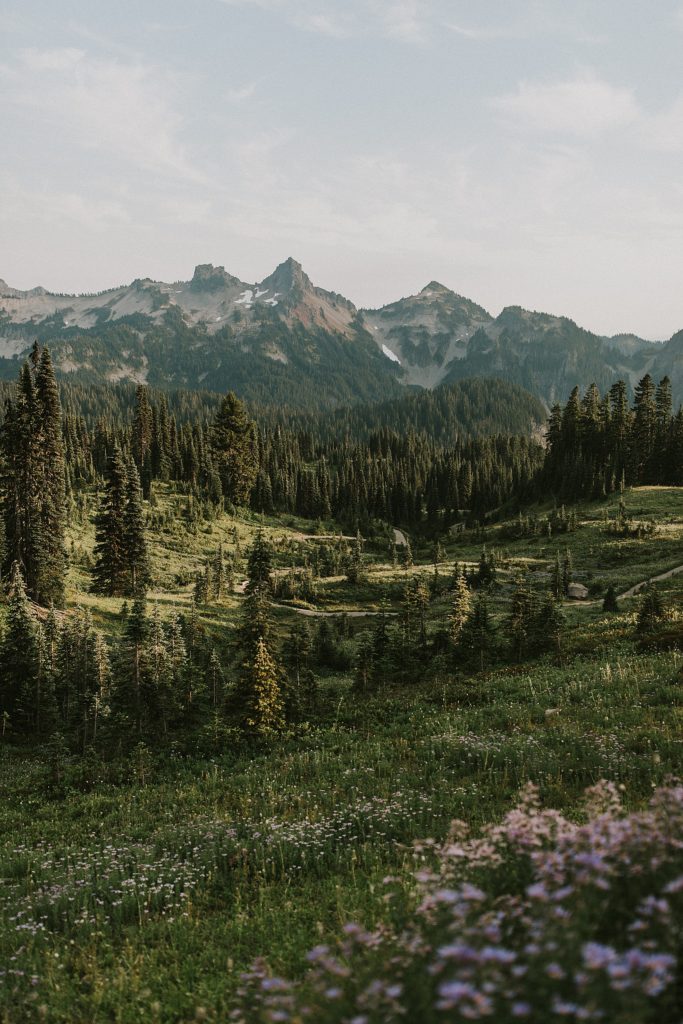
4. Leaving what you find wherever we go
To follow this rule, we’ll simply leave the areas we visit as they were when we arrived. No picking up wildflowers to put in your hair or add to your bouquet, no carving your initials with a heart into a tree, no picking plants to keep as memories, etc. Once you realize how much these types of activities harm the environment, it should be pretty easy to choose to avoid them!
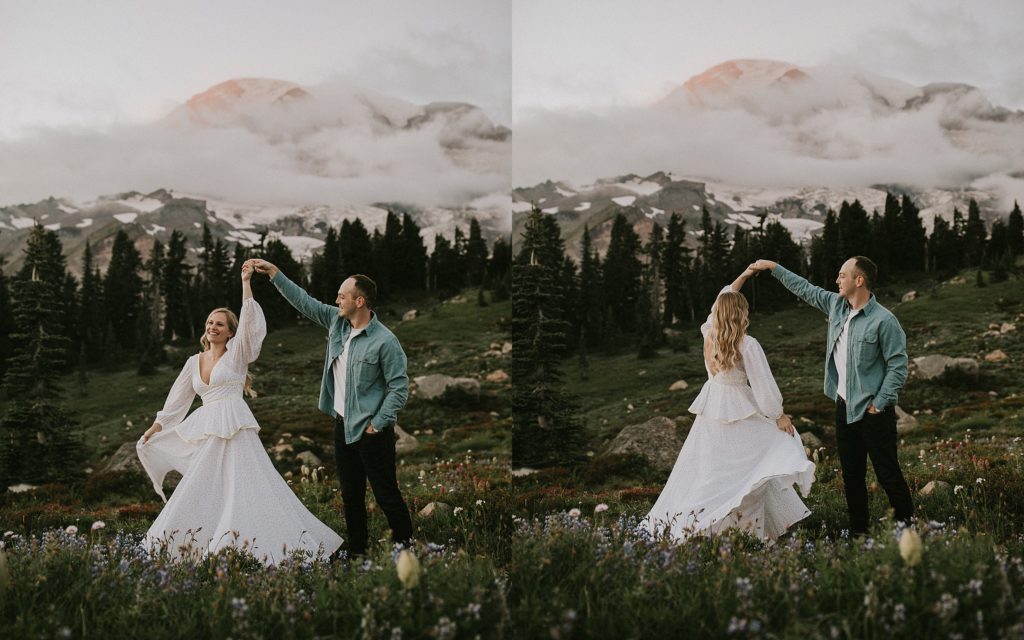
5. Minimizing the impact of your cozy campfire
If you decide to include a campfire during your elopement to make s’mores and sit by in the evening, we’ll make sure we build it safely and have a plan to dispose of the remains.
6. Respecting Rainier’s wildlife
If we see any wildlife during your elopement, we’ll observe it from a distance and keep as quiet + non disruptive as possible. My camera shutter can be fairly loud sometimes, so we’ll try to stay away from animals as much as possible to avoid causing them stresswith our voices + movements!
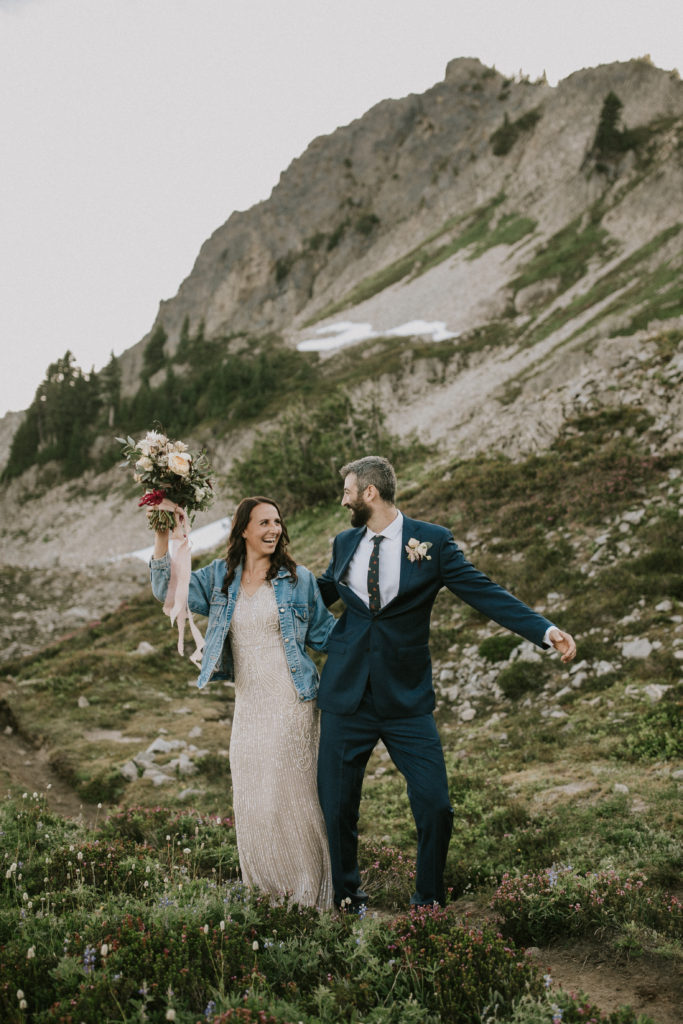
7. Being respectful of other mountain visitors
Finally, during your elopement, we will make sure to be respectful to other visitors. If you’re choosing to elope in the mountains, you won’t be able to play any music during your ceremony – instead, you’ll enjoy the sounds of nature! We don’t want to disrupt the ways anybody else around us is enjoying the outdoors, just as we wouldn’t want them to disrupt your peaceful time eloping together in nature.
Whew, that was a TON of info. I hope you can see just how passionate I am about protecting the outdoors, and how important I believe it is to incorporate that into my business + my couples’ experiences. I will always help you plan your elopement and make sure we minimize our impact as much as possible for your big day, no matter where you’ll be tying the knot. Let’s keep the outdoors beautiful together!
Please feel free to reach out and let me know if you have any questions about Leave No Trace policies!
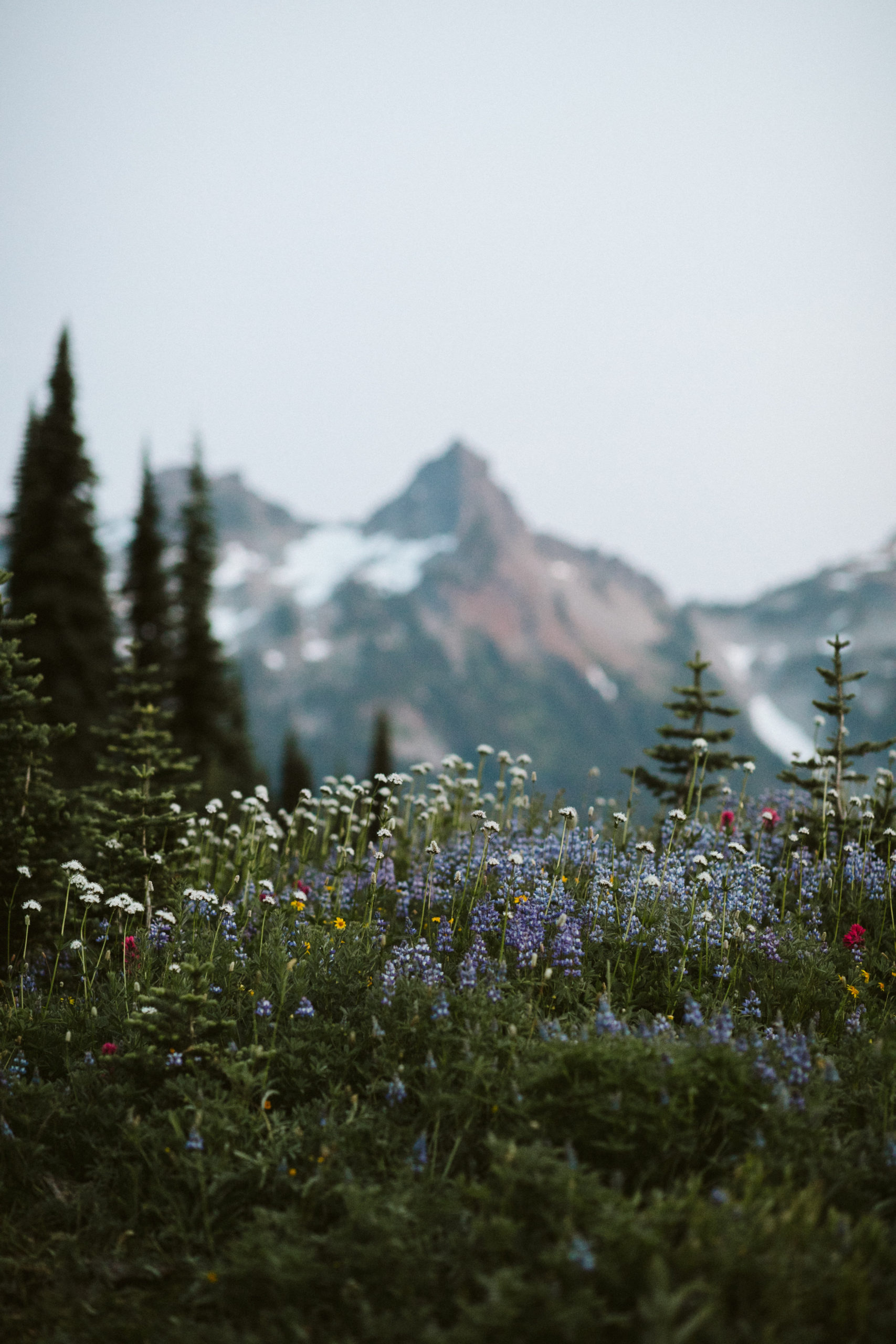
[…] If you want to learn about the Leave No Trace policies we follow when visiting Mt. Rainier then check out this blog! […]
[…] places like Mount Rainier National Park. That’s why I recently wrote an article all about how to Leave No Trace inside the park during your elopement, which I highly recommend you read and educate yourself with prior to […]
[…] Read more about how to Leave No Trace when visiting Mount Rainier here! […]
[…] have a whole article on How to Leave No Trace with Your Mountain Wedding at Mt. Rainier that I highly recommend you read while planning your elopement, even if you’re not eloping at […]
[…] For more tips on how to Leave No Trace during your session or elopement, check out this article! […]
[…] How to Leave No Trace with your Mountain Wedding at Mt. Rainier […]
[…] For more information on LNT, check out my article on How to Leave No Trace with your Mountain Wedding at Mt. Rainier! […]